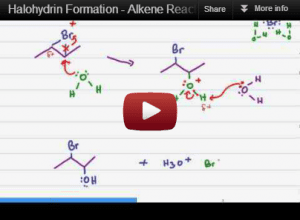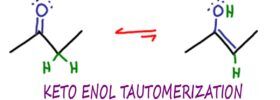 Alkene Reactions Series: Video 5
Alkene Reactions Series: Video 5
This tutorial takes you through the halohydrin formation mechanism, a type of electrophilic addition which adds both a halogen and alcohol to an alkene by using water instead of an inert solvent like CH2Cl2 or CCL4 to yield a halohydrin which features both a halogen and alcohol on the carbon chain
This video provides with a step by step breakdown of the mechanism and helps you understand WHY this reaction undergoes anti addition and still follows Markovnikov’s rule.
(Watch on YouTube: Halohydrin. Click cc on the bottom right for video transcription.)
<– Watch Previous Video: Halogenation of Alkenes Reaction Mechanism
–> Watch Next Video: Acid Catalyzed Hydration of Alkenes
This is Video 5 in the Alkene Reaction Mechanisms Video Series. Click HERE for the entire series.
Ready to test your skills? Try the Alkene Reactions Practice Quiz after watching the series!



Hi, I was wondering if you could explain the stereochemistry in the resulting products. More specifically, why OH and Br are in the same plane. Thank you
For the second halohydrin reaction with Cl 2 you added the OH in the secondary carbon instead of the halide. Should we always do that for any halohydrin reaction?
Does the same reaction occur with ethene?
i.e. Ethene + Bromine (water) ——-> ethylene bromohydrin
these videos are very helpful. Just wondering if you could explain when to use stereochemistry
So helpful! This type of step-by-step explanation is much appreciated.
You’re welcome, Celia!
how does the slight polarization of bromine happen?
on 1:56 minute of video
you r truly awesome
Thanks, Mobeena!
You make Organic chemistry so simple, thank you so much.
Thanks Cashman. Glad to help
If the reagents were 2 Iodines and Ethanol, would there be an extra Ethanol molecule that would come and take the Hydrogen away from the ethanol ion after it attaches to the secondary Carbon? Or would the extra Iodine be able to attach since there is only an alcohol and not water.
so would this be considered anti addition since they add on opposite sides of the double bond and steriochemistry antimarkovnikov since the cl ended up on the less substituted carbon?
Careful there Mary. It’s anti-addition as you said, but follows Markovnikov’s rule since the OH adds to the more substituted carbon atom. Markovnikov’s rule is about the carbocation intermediate stability, and this molecule puts more partial positive on the more substituted carbon
Can you have a step by step reaction for ozonlysis, and demercuration
Shama, did you check my complete alkene reaction series?
You are truly awesome!